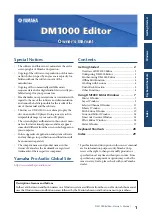
1 Introduction
This chapter addresses the following topics:
•
“LVM Features” (page 8)
•
“LVM Architecture” (page 9)
•
“Physical versus Logical Extents” (page 10)
•
“LVM Volume Group Versions” (page 11)
•
“LVM Device File Usage” (page 12)
•
“LVM Disk Layout” (page 16)
•
“LVM Limitations” (page 18)
•
“Shared LVM” (page 18)
LVM Features
Logical Volume Manager (LVM) is a storage management system that lets you allocate and manage
disk space for file systems or raw data. Historically, you treated your disks individually and in
terms of fixed-sized partitions; each disk or partition held a file system, swap space, boot area,
or raw data. With LVM, you do not need to assign a disk or fixed-sized partition to a single
purpose. Instead, consider the disks as a pool (or volume) of data storage, consisting of equal-sized
extents. Extents are allocated into virtual storage devices known as
logical volumes
, which can be
treated as disks.
LVM provides the following capabilities:
•
A logical volume size can be dynamically reduced or expanded to meet changing data needs.
For example, a logical volume can be as small or large as the file system mounted to it requires.
The file system can be extended without rebuilding it or the logical volume; reducing a file
system is more complex, and may require recreating the file system.
•
Small chunks of unused space from several disks can be combined to create a usable volume.
•
A logical volume can exceed the size of a single physical disk. This feature is called
disk
spanning
, because a single file system (and individual files) can span disks.
•
Up to six copies of identical data can be stored and updated simultaneously using LVM. This
feature is called
mirroring
a logical volume, and requires an optional product, HP
MirrorDisk/UX. See
“Increasing Data Availability Through Mirroring” (page 24)
.
•
Mirrored data can be configured to automatically create a new mirror to a separate disk
when one of the mirror copies fails. This feature is called
sparing
, and requires an optional
product, HP MirrorDisk/UX. See
“Increasing Disk Redundancy Through Disk Sparing”
(page 27)
.
•
A logical volume can be created so that logically contiguous data blocks (for example, chunks
of the same file) are distributed across multiple disks, which speeds I/O throughput for large
files when they are read and written sequentially. This feature is called
striping
. Striping can
be used in conjunction with mirroring. See
“Increasing Performance Through Disk Striping”
(page 31)
.
•
A point-in-time image of a logical volume can be created, called a
snapshot
logical volume.
See
“Creating and Administering Snapshot Logical Volumes” (page 103)
.
•
Devices accessed through multiple links can be configured to improve availability. If the primary
link to a device fails, LVM can switch automatically to an alternate link. This feature is called
multipathing
. See
“Increasing Hardware Path Redundancy Through Multipathing” (page 28)
.
8
Introduction









































